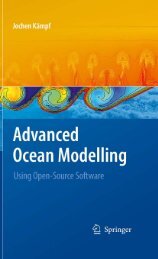Contents
Contents
Contents
- No tags were found...
You also want an ePaper? Increase the reach of your titles
YUMPU automatically turns print PDFs into web optimized ePapers that Google loves.
6.8 The Wind-Driven Circulation of the Ocean 143a f ow convergence/divergence in the bottom Ekman layer. For consistency with theanalytical solution of the Ekman-layer equations (see Cushman-Roisin, 1994), thelinear friction parameter has to be chosen according to:where the Ekman-layer thickness is given by (6.43).r = 0.5 δ ek f (6.51)6.8.10 Western Boundary CurrentsWestern boundary currents are regions in which the Sverdrup relation is not validand where frictional forces come into play. Western boundary currents are foundat the western continental rise of all oceans. The mechanism that leads to thesecurrents is called westward intensificatio , f rst described by Stommel (1948). Thetypical width of western boundary currents is 20–50 km and their speed can exceed1 m/s. On these scales, the direct impact of wind-driven Ekman pumping can beignored and the dynamical equations of our simplifie model governing this regimeare given by:− β f Qgeo y = rh o f( ∂ Qgeoy∂x− ∂ )Qgeo x∂ySince the velocity shear is much larger across the stream than along it; that is,∣ geo ∂ Q y /∂x ∣ ∣ >> ∣∂ geo Q x /∂y ∣ , the latter equation can be approximated as:∂ Q geoy∂x=−αQ geoy (6.52)where α = βh o /r or, with (6.51), α = 2βh o /( f δ ek ). The solution of the latterequation is:Q geoy = Q o (y)exp(−αx) (6.53)where x is distance from the western coast, and Q o (y) is the maximal value ofvolume transport occuring at x = 0. This maximum can be derived from the conditionsthat the boundary solution has to match the Sverdrup solution outside thewestern boundary. Cushman-Roisin (1994) details the full mathematical procedure.Figure 6.14 shows the fina structure of the meridional geostrophic f ow component.The width of the western boundary current can be estimated from the distancefrom the coast at which the volume transport according to (6.53) has decreased tofraction of exp (−π) (4.3%) of the coastal value. Using (6.53), this distance L isgiven by:L = 0.5π f δ ekβh o
















